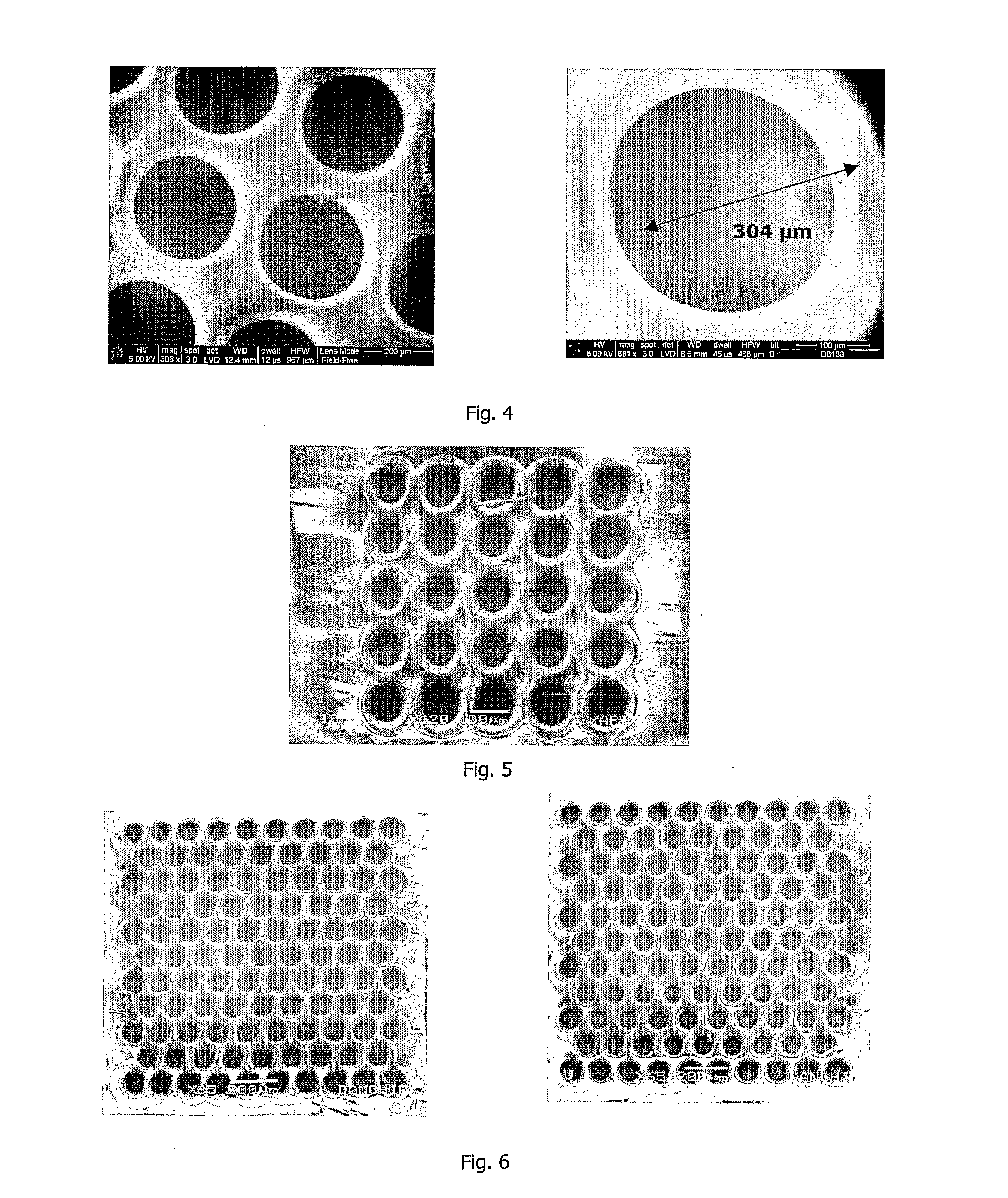Scaffold for composite biomimetic membrane
a biomimetic membrane and composite technology, applied in the direction of biochemistry apparatus and processes, material testing goods, instruments, etc., can solve the problems of compromising the simultaneous formation of a plurality of membrane units, affecting the painting quality, and not being able to scale into multi-aperture partitions straight forward, and achieves a high-effective membrane area
- Summary
- Abstract
- Description
- Claims
- Application Information
AI Technical Summary
Benefits of technology
Problems solved by technology
Method used
Image
Examples
example 1
Array Fabrication
[0122]To have an efficient membrane scaffold for, e.g. a filter membrane, the perforation level has to be as high as possible. Interactions from the production of neighbouring apertures in dense arrays influences the fabrication process when working with a CO2 laser could be predicted. Due to be a thermal process, heat is coupled in the material each time the beam hits the surface of the film. This could lead to a lowering of the threshold where material is evaporated and thus result in bigger apertures in the middle of the array. Furthermore, when getting closer together, the bulges around the apertures could accumulate and so get higher in arrays than with single apertures. To investigate to what extent this may be the case, different arrays with different distances between the apertures and different parameters had to be designed and tested. To start the investigation and production of a highly perforated membrane, a simple 5×5 array of apertures was designed. It...
example 2
Geometrical Examination of Arrays
[0123]After having optimized the main production parameters, samples with spacing ranging from 150 μm to 120 μm were produced and examined to characterize the arrays and the apertures geometrically. It was found that the apertures at a center to center distance of 150 μm were completely round, however, their shape changed when decreasing the spacing. The cause was that every new aperture influenced its neighbours more and more with decreasing distance. The thermal energy induced by the laser melted and evaporated the material. Evaporating material built up a pressure which ejected melted parts but also pushed the softened boundaries. By having hexagonal arranged apertures this resulted in the formation of box like or even hexagonal shaped apertures, cf. FIG. 6. Using the previous model an estimation of the bulge height could be made. The highest bulge will form at the spot where two apertures get closest to each other. However, it has to be noted tha...
example 3
Off Vector Delay and Spacing Consideration
[0126]The basic structure for this test was a hexagonal array with 10 apertures in each row and 11 rows. The distance from center to center (spacing) was chosen to be 250, 200, 150, 140, 130 and 120 μm. The optimal parameters for arrays with these spacings and an OVD of 1 μs were determined (Table 6).
TABLE 6Overview of the optimized parameters for the production ofapertures with an OVD of 1 μs with an intensity of 0.4 WOptimized parameters for the Off Vector Delay vs. spacing testspacing in μmAperturesspot lase duration250All5ms200All5ms1501st of each row5ms2nd of 1st rowRemaining4.8ms1401st of each row5ms2nd of first row4.8ms3rd of first row4.5msRemaining4ms1301st of each row5ms2nd of 1st row4.8ms3rd of 1st row4.5msRemaining4ms1201st of 1st row5ms1st hole of each row4.8ms2nd of 1st row3rd of 1st row4.5msRemaining4ms
PUM
| Property | Measurement | Unit |
|---|---|---|
| thick | aaaaa | aaaaa |
| thick | aaaaa | aaaaa |
| contact angles | aaaaa | aaaaa |
Abstract
Description
Claims
Application Information
 Login to View More
Login to View More - R&D Engineer
- R&D Manager
- IP Professional
- Industry Leading Data Capabilities
- Powerful AI technology
- Patent DNA Extraction
Browse by: Latest US Patents, China's latest patents, Technical Efficacy Thesaurus, Application Domain, Technology Topic, Popular Technical Reports.
© 2024 PatSnap. All rights reserved.Legal|Privacy policy|Modern Slavery Act Transparency Statement|Sitemap|About US| Contact US: help@patsnap.com










